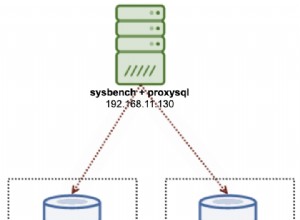JDBC es simplemente un estándar Java SE de acceso a la base de datos que ofrece las interfaces estándar, por lo que no está realmente atado a una implementación específica de JDBC. MySQL Java Connector (Connector/J) es una implementación de las interfaces JDBC solo para bases de datos MySQL. Por experiencia, estoy involucrado en un proyecto que usa una gran cantidad de datos usando MySQL, y en su mayoría preferimos MyISAM para los datos que se pueden generar:permite lograr un rendimiento mucho mayor al perder transacciones, pero en general, MyISAM es más rápido. pero InnoDB es más confiable.
También me pregunté por el rendimiento de las declaraciones INSERT hace aproximadamente un año, y encontré el siguiente código de prueba antiguo en mi estante de código (lo siento, es un poco complejo y está un poco fuera del alcance de su pregunta). El siguiente código contiene ejemplos de 4 formas de insertar los datos de prueba:
- único
INSERTs; - lotes
INSERTs; - masa manual
INSERT(nunca lo use - es peligroso); - y finalmente preparados a granel
INSERT).
Utiliza TestNG como ejecutor, y utiliza un legado de código personalizado como:
- el
runWithConnection()método:garantiza que la conexión se cierre o se vuelva a colocar en el grupo de conexiones después de que se ejecute la devolución de llamada (pero el código a continuación utiliza una estrategia no confiable de cierre de la declaración, incluso sintry) /finallypara reducir el código); IUnsafeIn<T, E extends Throwable>- una interfaz de devolución de llamada personalizada para los métodos que aceptan un solo parámetro pero que potencialmente lanzan una excepción de tipo E, como:void handle(T argument) throws E;.
package test;
import test.IUnsafeIn;
import java.sql.Connection;
import java.sql.PreparedStatement;
import java.sql.SQLException;
import static java.lang.String.format;
import static java.lang.String.valueOf;
import static java.lang.System.currentTimeMillis;
import core.SqlBaseTest;
import org.testng.annotations.AfterSuite;
import org.testng.annotations.BeforeSuite;
import org.testng.annotations.BeforeTest;
import org.testng.annotations.Test;
public final class InsertVsBatchInsertTest extends SqlBaseTest {
private static final int ITERATION_COUNT = 3000;
private static final String CREATE_TABLE_QUERY = "CREATE TABLE IF NOT EXISTS ttt1 (c1 INTEGER, c2 FLOAT, c3 VARCHAR(5)) ENGINE = InnoDB";
private static final String DROP_TABLE_QUERY = "DROP TABLE ttt1";
private static final String CLEAR_TABLE_QUERY = "DELETE FROM ttt1";
private static void withinTimer(String name, Runnable runnable) {
final long start = currentTimeMillis();
runnable.run();
logStdOutF("%20s: %d ms", name, currentTimeMillis() - start);
}
@BeforeSuite
public void createTable() {
runWithConnection(new IUnsafeIn<Connection, SQLException>() {
@Override
public void handle(Connection connection) throws SQLException {
final PreparedStatement statement = connection.prepareStatement(CREATE_TABLE_QUERY);
statement.execute();
statement.close();
}
});
}
@AfterSuite
public void dropTable() {
runWithConnection(new IUnsafeIn<Connection, SQLException>() {
@Override
public void handle(Connection connection) throws SQLException {
final PreparedStatement statement = connection.prepareStatement(DROP_TABLE_QUERY);
statement.execute();
statement.close();
}
});
}
@BeforeTest
public void clearTestTable() {
runWithConnection(new IUnsafeIn<Connection, SQLException>() {
@Override
public void handle(Connection connection) throws SQLException {
final PreparedStatement statement = connection.prepareStatement(CLEAR_TABLE_QUERY);
statement.execute();
statement.close();
}
});
}
@Test
public void run1SingleInserts() {
withinTimer("Single inserts", new Runnable() {
@Override
public void run() {
runWithConnection(new IUnsafeIn<Connection, SQLException>() {
@Override
public void handle(Connection connection) throws SQLException {
for ( int i = 0; i < ITERATION_COUNT; i++ ) {
final PreparedStatement statement = connection.prepareStatement("INSERT INTO ttt1 (c1, c2, c3) VALUES (?, ?, ?)");
statement.setInt(1, i);
statement.setFloat(2, i);
statement.setString(3, valueOf(i));
statement.execute();
statement.close();
}
}
});
}
});
}
@Test
public void run2BatchInsert() {
withinTimer("Batch insert", new Runnable() {
@Override
public void run() {
runWithConnection(new IUnsafeIn<Connection, SQLException>() {
@Override
public void handle(Connection connection) throws SQLException {
final PreparedStatement statement = connection.prepareStatement("INSERT INTO ttt1 (c1, c2, c3) VALUES (?, ?, ?)");
for ( int i = 0; i < ITERATION_COUNT; i++ ) {
statement.setInt(1, i);
statement.setFloat(2, i);
statement.setString(3, valueOf(i));
statement.addBatch();
}
statement.executeBatch();
statement.close();
}
});
}
});
}
@Test
public void run3DirtyBulkInsert() {
withinTimer("Dirty bulk insert", new Runnable() {
@Override
public void run() {
runWithConnection(new IUnsafeIn<Connection, SQLException>() {
@Override
public void handle(Connection connection) throws SQLException {
final StringBuilder builder = new StringBuilder("INSERT INTO ttt1 (c1, c2, c3) VALUES ");
for ( int i = 0; i < ITERATION_COUNT; i++ ) {
if ( i != 0 ) {
builder.append(",");
}
builder.append(format("(%s, %s, '%s')", i, i, i));
}
final String query = builder.toString();
final PreparedStatement statement = connection.prepareStatement(query);
statement.execute();
statement.close();
}
});
}
});
}
@Test
public void run4SafeBulkInsert() {
withinTimer("Safe bulk insert", new Runnable() {
@Override
public void run() {
runWithConnection(new IUnsafeIn<Connection, SQLException>() {
private String getInsertPlaceholders(int placeholderCount) {
final StringBuilder builder = new StringBuilder("(");
for ( int i = 0; i < placeholderCount; i++ ) {
if ( i != 0 ) {
builder.append(",");
}
builder.append("?");
}
return builder.append(")").toString();
}
@SuppressWarnings("AssignmentToForLoopParameter")
@Override
public void handle(Connection connection) throws SQLException {
final int columnCount = 3;
final StringBuilder builder = new StringBuilder("INSERT INTO ttt1 (c1, c2, c3) VALUES ");
final String placeholders = getInsertPlaceholders(columnCount);
for ( int i = 0; i < ITERATION_COUNT; i++ ) {
if ( i != 0 ) {
builder.append(",");
}
builder.append(placeholders);
}
final int maxParameterIndex = ITERATION_COUNT * columnCount;
final String query = builder.toString();
final PreparedStatement statement = connection.prepareStatement(query);
int valueIndex = 0;
for ( int parameterIndex = 1; parameterIndex <= maxParameterIndex; valueIndex++ ) {
statement.setObject(parameterIndex++, valueIndex);
statement.setObject(parameterIndex++, valueIndex);
statement.setObject(parameterIndex++, valueIndex);
}
statement.execute();
statement.close();
}
});
}
});
}
}
Eche un vistazo a los métodos anotados con la anotación @Test:en realidad ejecutan INSERT declaraciones. Además, eche un vistazo a CREATE_TABLE_QUERY constante:en el código fuente usa InnoDB produciendo los siguientes resultados en mi máquina con MySQL 5.5 instalado (MySQL Connector/J 5.1.12):
InnoDB
Single inserts: 74148 ms
Batch insert: 84370 ms
Dirty bulk insert: 178 ms
Safe bulk insert: 118 ms
Si cambia el CREATE_TABLE_QUERY InnoDB a MyISAM, vería un aumento significativo en el rendimiento:
MyISAM
Single inserts: 604 ms
Batch insert: 447 ms
Dirty bulk insert: 63 ms
Safe bulk insert: 26 ms
Espero que esto ayude.
UPD:
Para la cuarta forma, debe personalizar correctamente el max_allowed_packet en mysql.ini (el [mysqld] sección) para que sea lo suficientemente grande como para admitir paquetes realmente grandes.




